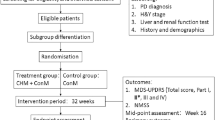Abstract
Objective
To investigate the prevalence and spectrum of complementary and alternative medicine (CAM) application and its related-factors in Parkinson’s disease (PD) patients in China.
Methods
A structured questionnaire regarding the use of CAMs was administered to PD patients by face-to-face interview. Demographic and social variables, clinical characteristics and treatments, and the related factors of PD were also surveyed.
Results
Ninety out of 113 patients (79.6%) reported that they had received CAMs treatment, of which 48.6% (55/113) patients had received CAMs treatment for PD. The top 3 kinds of CAMs for PD were Chinese materia medica, rehabilitation exercise, and acupuncture ordinally. The source of information regarding CAMs treatment mainly came from relatives and friends (51.8%, 73 cases), followed by physicians (31.9%, 45 cases), and medias such as television, newspapers or the internet (16.3%, 28 cases). Fifty percent of CAM users reported a good therapeutic efficacy, whereas 39% patients reported that they felt neither better nor worse after the treatment, while 11% patients claimed worsening of symptoms. Multiple correspondence analyses survey found the main factors affecting the selectivity of CAMs ranked in the following order: income, education, occupation, habitation, age at onset, Hoehn and Yahr staging, PD duration, and gender.
Conclusion
CAMs, especially Chinese materia medica, rehabilitation exercise, and acupuncture, are widely used for PD patients in China.
Similar content being viewed by others

References
Schuepbach WM, Rau J, Knudsen K, Volkmann J, Krack P, Timmermann L, et al. Neurostimulation for Parkinson’s disease withearly motor complications. N Engl J Med 2013;368:610–622.
Suchowersky O, Gronseth G, Perlmutter J, Reich S, Zesiewicz T, Weiner WJ, et al. Practice parameter: neuroprotective strategies and alternative therapies for Parkinson disease (an evidence-based review): report of the Quality Standards Subcommittee of the American Academy of Neurology. Neurology 2006;66:976–982.
Calabresi P, Di Filippo M, Ghiglieri V, Tambasco N, Picconi B. Levodopa-induced dyskinesias in patients with Parkinson’s disease: filling the bench-to-bedside gap. Lancet Neurol 2010;9:1106–1117.
Wood LD, Neumiller JJ, Setter SM, Dobbins EK. Clinical review of treatment options for select nonmotor symptoms of Parkinson’s disease. Am J Geriatr Pharmacother 2010;8:294–315.
Zesiewicz TA, Evatt ML. Potential influences of complementary therapy on motor and non-motor complications in Parkinson’s disease. CNS Drugs 2009;23:817–835.
Bomar PJ. Comments on complementary and alternative healing modalities. Int J Nurs Pract 2013;19(S2):1–6.
Rajendran PR, Thompson RE, Reich SG. The use of alternative therapies by patients with Parkinson’s disease. Neurology 2001;57:790–794.
Ferry P, Johnson M, Wallis P. Use of complementary therapies and nonprescribed medication in patients with Parkinson’s disease. Postgrad Med J 2002;78:612–614.
Pecci C, Rivas MJ, Moretti CM, Raina G, Ramirez CZ, Diaz S, et al. Use of complementary and alternative therapies in outpatients with Parkinson’s disease in Argentina. Mov Disord 2010;25:2094–2098.
Lökk J, Nilsson M. Frequency, type and factors associated with the use of complementary and alternative medicine in patients with Parkinson’s disease at a neurological outpatient clinic. Park Relat Disord 2010;16:540–544.
Tan LC, Lau PN, Jamora RD, Chan ES. Use of complementary therapies in patients with Parkinson’s disease in Singapore. Mov Disord 2006;21:86–89.
Kim SR, Lee TY, Kim MS, Lee MC, Chung SJ. Use of complementary and alternative medicine by Korean patients with Parkinson’s disease. Clin Neurol Neurosurg 2009;111:156–160.
Zheng GQ. Therapeutic history of Parkinson’s disease in Chinese medical treatises. J Altern Complement Med 2009;15:1223–1230.
Wang Y, Lin XM, Zheng GQ. Traditional chinese medicine for Parkinson’s disease in china and beyond. J Altern Complement Med 2011;17:385–388.
Hughes AJ, Daniel SE, Kilford L, Lees AJ. Accuracy of clinical diagnosis of idiopathic Parkinson’s disease: a clinico-pathological study of 100 cases. J Neurol Neurosurg Psychiatry 1992;55:181–184.
Hoehn MM, Yahr MD. Parkinsonism: onset, progression, and mortality. Neurology 1967;7:427–442.
World Health Organization Western Pacific Region. WHO international standard terminologies on traditional medicine in the Western pacific region. Geneva: World Health Organization; 2007:v.
Hoffman DL, Franke GR. Correspondence Analysis: Graphical Representation of Categorical Data in Marketing Research. J Market Res 1986;23:213–227.
Ryan M, Johnson MS. Use of alternative medications in patients with neurologic disorders. Ann Pharmacother 2002;36:1540–1545.
Zhang ZX, Roman GC, Hong Z, Wu CB, Qu QM, Huang JB, et al. Parkinson’s disease in China: prevalence in Beijing, Xian, and Shanghai. Lancet 2005;365:595–597.
Eisenberg DM, Davis RB, Ettner SL, Appel S, Wilkey S, Van Rompay M, et al. Trends in alternative medicine use in the United States, 1990–1997: resultsof a follow-up national survey. JAMA 1998;280:1569–1575.
Author information
Authors and Affiliations
Contributions
Pan XW was in charge of the study, settled the questionnaires, conducted the survey, identified the Inclusions, extracted and analysis the data and wrote the manuscript. Zhang XG assisted to collect and analyze the data, and wrote the manuscript. Chen XC, Lu Q, Zheng JL, and Jin J participated in the questionnaire survey and collected the data. Hu YS and Han LY guided and supervised the progress of the study. Zheng GQ guided the instruction of the study and analysis of data, took critical revision of the manuscript.
Corresponding author
Additional information
Conflict of Interest
The authors declare that they have no competing interests.
Supported by the Project of Wenzhou Municipal Science and Technology Bureau in Zhejiang Province (No. Y20130337); Administration of Traditional Chinese Medicine of Zhejiang Province (No. 2010ZQ010); the Young and Middle-Aged University Discipline Leaders of Zhejiang Province, China (No. 2013277, G.-q.Z.); Zhejiang Provincial Program for the Cultivation of High-level Health Talents (No. 2015, G.-q.Z.)
Supporting Information
Rights and permissions
About this article
Cite this article
Pan, Xw., Zhang, Xg., Chen, Xc. et al. A Survey of Application of Complementary and Alternative Medicine in Chinese Patients with Parkinson’s Disease: A Pilot Study. Chin. J. Integr. Med. 26, 168–173 (2020). https://doi.org/10.1007/s11655-018-2560-y
Accepted:
Published:
Issue Date:
DOI: https://doi.org/10.1007/s11655-018-2560-y


